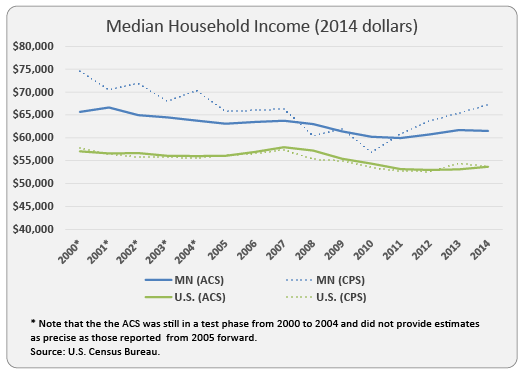Growth in Minnesota’s median household income doesn’t lead the nation
Last March Center of the American Experiment published “Minnesotans on the Move to Lower Tax States 2016,” in which I analyzed IRS migration data. Minnesota, according to this IRS data, has been consistently losing taxpaying households since 2002 and between 2013 and 2014 the state, on net, lost nearly $1 billion in income due to this negative migration trend.
These data also provide convincing evidence that Minnesota’s high taxes are influencing decisions on where to move. People tend to be moving to lower tax states. Five of the ten states that, on net, receive the most Minnesotans don’t impose an income tax. Moreover, Minnesota loses top earners—people making more than $200,000 who are subject to Minnesota’s top income tax rate—at a much higher rate than most states. In fact, the state’s rate of income loss from these people ranked 47th between 2013 and 2014.
I summarized my analysis in a Star Tribune commentary, which drew a lot of attention and discussion—715 comments to be exact.
The Dayton administration, however, did not care for the facts I outlined. Cynthia Bauerly, the commissioner of Minnesota’s Department of Revenue, wrote a counterpoint to try to undercut my findings.
A side note here. Many people expressed surprise to me that a sitting commissioner would get involved in a public debate like this. Unfortunately for anyone who cares about good government, a main legacy of the Dayton administration will be this unprecedented politicization of state agencies.
Getting back to the main point, I’ve already answered a number of objections from Comm. Bauerly and other critics, but I recently ran across data that refutes one of her lead points on how Minnesota remains an attractive place to move to.
Bauerly claimed, “Median income increased in Minnesota every year from 2011 to 2014, according to Census Bureau information. In fact, Minnesota led the nation in median income growth from 2010-14.”
Relying on the same data source, The American Prospect made similar points to show how Minnesota bests Wisconsin in a report entitled, “The High Road Wins: How and why Minnesota is outpacing Wisconsin.” The article was penned by Ann Markusen, professor emerita at the University of Minnesota’s Humphrey School of Public Affairs. She claimed median household income grew by 16.4 percent between 2010 and 2013.
I would love to celebrate such growth, but it seemed entirely improbable considering we haven’t seen anything approaching first in the nation growth on any other economic measure.
I did find their source. It is data from the U.S. Census Bureau Current Population Survey (CPS) and it does support their claim. The trouble is, it’s an incredibly imprecise estimate and the Census Bureau says not to use it.
The Census also administers the American Community Survey (ACS). In a document labeled, “Guidance on When to Use Each Survey,” the Census instructs, “To compare states with each other, we recommend using the ACS one-year estimates.” No doubt this recommendation is due to the greater precession delivered by the ACS’s sample size, which samples 3 million addresses compared to the 100,000 addresses sampled by the CPS. The CPS, according to the Census, is really only of value for “examining historical trends.”
All that said, what does Minnesota’s median household income look like under the ACS?
The chart below compares Minnesota to U.S. median household income under both the CPS and the ACS. One thing is clear, Minnesota is not leading the nation in median household income growth based on ACS estimates. The wild swings in income reported by the CPS diverge drastically from ACS estimates. Changes estimated by the ACS are moderate and in step with U.S. averages.
Minnesota has emerged from the lows of the Great Recession stronger than the U.S., but not substantially stronger—not nation-leading stronger. And Minnesota’s change in income starts looking distinctly average when trends are extended back to 2005 and 2000.
The Minnesota Dept. of Revenue and the University of Minnesota professor should know better than to use the CPS to compare states on income. They specifically violated the Census Bureau’s guidance, and it is important to get these details right. Minnesotans need to know just how well–or not so well–the state’s economy is performing. Minnesota can and should do better than average.
